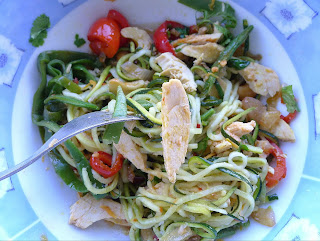My potato harvest this spring is pretty puny. The biggest spuds are golf-ball sized. Most are more like marbles. I’m glad they are not the only thing that keeps me from famine! Still, they deserve some celebration.
I have a recipe for a very old-fashioned potato dish called “ajopollo.” Ajopollo literally means “garlic-chicken.” But there is absolutely no chicken in the preparation! Garlic, yes. The name possibly derives from el tiempo de hambre, the times of hunger, when an ama de casa had to feed a family on subsistence foods.
Ajopollo is a sauce made with crushed almonds and bread, garlic, olive oil and “saffron.” Saffron, in poorer homes, does not mean the pricey golden spice, but yellow coloring.
The simple potato dish with its sauce is served as a starter, in place of soup, with or without a poached or fried egg. With the addition of fish or clams it becomes a main dish.
In honor of my home-grown potatoes, I’m using real saffron and only almonds to thicken the sauce, instead of almonds plus bread. In the humble original, water is the cooking liquid. I’m using a good chicken stock. Gilding the potatoes and putting the pollo into ajopollo. It makes a delightful dish.
 |
| A saffron-almond sauce naps the tender potatoes. |
 |
| Ajopollo can be served as a tapa. |
 |
| Add a poached egg. Starter or lunch? |
 |
| Clams and a few fava beans turn potatoes into a more substantial dish. |
Potatoes in Garlicky (Not)Chicken Sauce
Patatas en Ajopollo
Patatas en Ajopollo
Mealy brown/gold/russet potatoes are best for this dish, because they absorb so much flavor. However, they do easily overcook and disintegrate. Firm red potatoes keep their shape. Whichever you use, cut them into pieces of equal size (about 1 ½ inches). Peel or don’t peel, as you prefer.
Depending on what type of potato you use, cooking time will vary. You may need additional cooking liquid. Add stock or water so that the almond-thickened sauce is the consistency of a light cream sauce. It should nap the potatoes. If you are using water rather than seasoned stock, be sure to add salt generously.
Serves 6.
Depending on what type of potato you use, cooking time will vary. You may need additional cooking liquid. Add stock or water so that the almond-thickened sauce is the consistency of a light cream sauce. It should nap the potatoes. If you are using water rather than seasoned stock, be sure to add salt generously.
Serves 6.
2 pounds small potatoes
¼ cup olive oil
½ cup blanched and skinned almonds
5 cloves garlic, peeled
½ teaspoon saffron threads
3 tablespoons hot water
1 tablespoon chopped parsley + more to garnish
2 cups chicken stock or water
1 bay leaf
Freshly ground black pepper
Salt to taste
¼ cup olive oil
½ cup blanched and skinned almonds
5 cloves garlic, peeled
½ teaspoon saffron threads
3 tablespoons hot water
1 tablespoon chopped parsley + more to garnish
2 cups chicken stock or water
1 bay leaf
Freshly ground black pepper
Salt to taste
Scrub potatoes. Peel them if you wish. Cut them in halves or quarters so that all are more or less the same size. (If prepping in advance, cover the potatoes with water until ready to cook.)
Heat the oil in a pan or skillet and fry the almonds and cloves of garlic, turning them until golden. Skim the almonds and garlic out of the oil and reserve.
Crush the saffron threads and put them in a small bowl. Add the hot water and allow to infuse 5 minutes.
Place the almonds, cloves of garlic, saffron water and parsley in a blender with ½ cup of the stock. Blend to make a smooth paste.
Add the potatoes (drained if they have been covered with water) to the remaining oil in the pan. Cook them on medium heat, stirring, for 5 minutes. Do not let them brown. Add remaining 1 ½ cups of stock to the pan with bay leaf, pepper and salt. Bring to a boil, lower heat so the liquid just bubbles. Cover the pan and cook the potatoes 5 minutes.
Stir the almond paste from the blender into the potatoes. Continue cooking, shaking the pan frequently so the potatoes and sauce do not stick, until potatoes are tender when probed with a skewer, about 10 minutes longer.
Serve potatoes and sauce garnished with additional chopped parsley.
Heat the oil in a pan or skillet and fry the almonds and cloves of garlic, turning them until golden. Skim the almonds and garlic out of the oil and reserve.
Crush the saffron threads and put them in a small bowl. Add the hot water and allow to infuse 5 minutes.
Place the almonds, cloves of garlic, saffron water and parsley in a blender with ½ cup of the stock. Blend to make a smooth paste.
Add the potatoes (drained if they have been covered with water) to the remaining oil in the pan. Cook them on medium heat, stirring, for 5 minutes. Do not let them brown. Add remaining 1 ½ cups of stock to the pan with bay leaf, pepper and salt. Bring to a boil, lower heat so the liquid just bubbles. Cover the pan and cook the potatoes 5 minutes.
Stir the almond paste from the blender into the potatoes. Continue cooking, shaking the pan frequently so the potatoes and sauce do not stick, until potatoes are tender when probed with a skewer, about 10 minutes longer.
Serve potatoes and sauce garnished with additional chopped parsley.
More potato recipes:






































